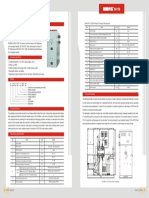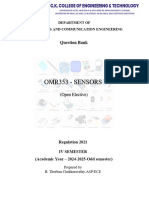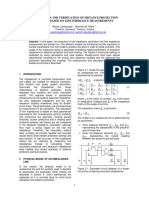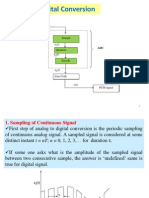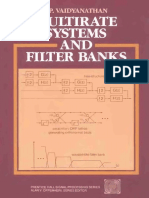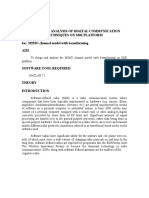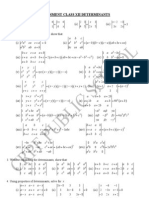DSP
DSP
Uploaded by
bbmathiCopyright:
Available Formats
DSP
DSP
Uploaded by
bbmathiOriginal Description:
Original Title
Copyright
Available Formats
Share this document
Did you find this document useful?
Is this content inappropriate?
Copyright:
Available Formats
DSP
DSP
Uploaded by
bbmathiCopyright:
Available Formats
EC 2314 DIGITAL SIGNAL PROCESSING
FIFTH SEMESTER
ELECTRICAL AND ELECTRONICS ENGINEERING
(REGULATION 2008)
UNIVERSITY QUESTION BAN !ITH ANS!ERS
UNIT"1
PART"A #2 MARS$
Q%1 !&'( ')* *+*, ',- .-- /01,'23(N.+ 4 D*5 2010)
Ans:
A continuous (or) discrete time signal x(t) is said to be an even
(symmetric) signal if it is satisfies the condition
) (t x
=
) ( t x
for all t
) (n x
=
) ( n x
for all n
A continuous (or) discrete time signal x(t) said to be an odd
signal (Asymmetric) signal it is satisfies the condition
) (t x
= -
) ( t x
for all t
) (n x
= -
n x (
for all n
E6'782*9
Q%2 D*:0,* A20'/0,1 *::*5(%(N.+ 4 D*5"2010)
Ans: Let us consider a band limited signal x(t) having no
frequency component for ||!
m
if e sample the signal x(t)
ith a sampling frequency f f
m
"#he periodic continuation of
x() results in spectral overlap" $n this case the spectrum x()
cannot be recovered using a lo pass filter" #his effect as
aliasing effect"
#o avoid aliasing:
%"x(t) is strictly band limited
&"
2
s m
f f >
Q%3 D*:0,* S'7820,1 (&*.)*7 (A8)024M'; 2011)
Ans: A band limited continuous time signal ith a higher
frequency
m
f
'( can be uniquely recovered from its samples
provided the sampling rate
2
s m
f f >
samples per seconds"
Q%4 !&'( 0/ 20,*') (07* 0,+')0',( /;/(*73 (A8)02 4 M';
2011)
A,/9 An L#$ system is one hich possesses to of the basic
properties using linearity and time invariance
L0,*')0(;: An L#$ system obeys super position principles hich
states that the output of the system to be a eighted sum of its
equal to the corresponding eighted sum of outputs to each of
the individuals inputs
[ ] [ ] [ ]
1 2 1 2
( ) ( ) ( ) ( ) T ax n bx n Ta x n Tb x n + +
T07* 0,+')0',( /;/(*79 if the input )output relation of a
system does not vary ith time" #he system said to be time
invariant"
Q%< D*:0,* N;1=0/( )'(*%(M'; 4 >=,* 2012)
A,/9 *yquist rate of sampling is the theoretical minimum
sampling rate at hich a signal can be sampled and still be
reconstructed from its samples ithout any distortion
*yquist rate
m N
f f 2
'(
#o avoid aliasing
m N
f f 2
Q%? S('(* ',- 8).+* (&* (07* )*+*)/'2 8).8*)(; .: :=))0*)
()',/:.)7 (M'; 4 >=,* 2012)
A,/9 $f
{ } ) ( ) ( w x n x F
{ } ) ( ) ( w x n x F
+roof:
{ }
n
n x n x F ) ( ) (
iwn
e
n
n x ) (
jwn
e
n
n x ) (
n w j
e
) (
{ } ) ( ) ( w x n x F
Q%@ G0+*, ' 5.,(0,=.=/ (07* /01,'2 A&'(
0/ (&* ,;B=0/( )'(* ',- :=,-'7*,('2 :)*B=*,5; .: (&*
/01,'23(M'; 4 >=,* 2013)
A,/9
500
m
C
500 f 2
m m
C
250
2
500
f
m
'(
*yquist rate
250 x 2 f 2 f
m N
500 '(
Q%8 D*(*)70,* A&*(&*) 6#,$D=#,$ 0/ 8.A*) /01,'2 (.)) ',
*,*)1; /01,'2 #M'; 4 >=,* 2013$
A,/9 ,nergy =
n
2
) n ( x
0 n
1
, =
, = - so given signal is poer signal
.ondition for energy signal is (/ 0 , 0 )-finite value of
energy
P')("B (1? M')E/)
Q%1 ') (0) !&'( -. ;.= 7*', F; N;1=0/( )'(*3 G0+* 0/
/01,0:05',5* (?) (N.+ 4 D*5 2010)
A,/9 *yquist rate of sampling is the theoretical minimum
sampling rate at hich a signal can be sampled and still be
reconstructed from its samples ithout any distortion
- $t is 1the theoretical minimum2 because hen the *yguist
rate of sampling is used
- 3nly ideal L+4 can be used to extract x() from x
s
()
- $t is alays equal to &f
m
here f
m
is minimum frequency
component present in the signal"
- A signal sampled at greater than nyquist rate is said to be
over sampled and a signal sampled at less than is nyquist
rate is said to under sampled
*yquist interval:-
*yquist interval is the time interval beteen anty to ad5acent
samples hen sampling rate is nyquist rate
*yquist rate N
f
=&f
m
'(
*yquist interval =
N
f
1
=
m
f 2
1
sec"
00)E682'0, (&* 52'//0:05'(0., .: -0/5)*(* (07* /01,'2%(10)
(N.+ 4 D*5 2010)
A,/9 .lassification of discrete time signal (%/)
a" +eriodic 6 Aperiodic signal"
b" ,nergy 6 +oer signal"
c" .ausal 6 *on-causal signal"
d" ,ven 6 odd signal"
a" +eriodic 6 Aperiodic signal
A discrete time signal x(n)is said to be +eriodic" $f
it is satisfies the condition
7(n)8x(n8*) for all integers n"
- #he smallest value of * hich satisfies the above
condition is 9non as fundamental period"
- $f the above condition is not satisfied even for n: then the
discrete time signal is Aperiodic
,nergy 6 +oer signal:
A periodic time signal x(n)",nergy signal , =
n
n x
2
) (
+oer signal:
+ =
Lt
N
1 2
1
+ N
N
-N
2
) (
n
n x
A signal is said to be an energy signal if only its total
enegy , is finite (/ 0 , 0 ) 6 average poer p=/
*on periodic signals are examples of poer signal
A discrete time signal is x(n)is said to be odd
(Asymmetric ) if it is satisfies the folloing condition
) ( n x
=-
) (n x
(or)
) (n x
= -
) ( n x
for all n
Q%2 (0) E682'0, 0, -*('02 (&* B=',(0G'(0., .: -010('2 /01,'2
(8) (N.+ 4 D**5 2010)
A,/9
Q=',(0G'(0.,9 the process of converting discrete time
continuous amplitude signal x(n) into a discrete time amplitude
signal x q (n) is 9non as quanti(ation hich is done by
rounding off each sample in x(n) to the nearest quanti(ation
level" #hen each sample in x q (n) is represented by a finite
number of digits using a coder
- $f a signal is represented by b8t % bit used ith amplitude
range ; than quanti(ation that can be represented is &
1 + b
#he difference beteen the quanti(ation step in terms of
the range of the signal is
q=
on quantizati of number
signal of range
=
1
2
+ b
R
- $t is necessary to scale the signal: if the range of the signal
exceeds 1 t
- <e can represent the sample values by a sequences
x(n)==/:/">&/:/"?@:/"?@:/"@A@:-/"/B:-/">&@:/"?@:-
/"?@:-/"@A@:/C
- Let us use a b8% bit AD. to represent the above sequence
ith b8% binary digit
1
2
+ b
quanti(ation levels can be
obtained and the input can be resolved to one part in
1
2
+ b
"
$f the input signal has a range of &v: then the quanti(ation
step si(e is equal to signal
q=
b
b
+
2
2
2
1
- #he process of converting x(n) to a finite number of
introduces on error 9non as quanti(ation noise" $t is
defined as the difference beteen quantified value and
the actual value sample value
) ( ) ( n x n e
q
)
) (n x
(00) Eampling techniques:
$mpulse sampling
*atural sampling
4lat top sampling
$mpulse sampling
- #he above analog signal x(t) is multiplied ith a nit
impulse sequence ith uniform interval
- Eample an analog ave form ith a delta function
) (t
T
"
- Assume x(t) is band limited it is outside the interval (-
s
f
0
f
0
s
f
)
- Eample at x(t) at times t=n#s by periodic train of delta
function
) (t
T
) (t
T
n
s
nT t ) (
4ourier transform of
) (t
T
) ( f
T
s
T
1
n
s
nT t ) (
<here s
f
=
Ts
1
- Eampling can be achieved mathematically ass the product
of x(t) ith
) (t
T
) (t x
s
) (t x ) (t
T
"""""""" (%)
=
n
s
nT t t x ) ( ) (
=
n
s s
nT t nT x ) ( ) (
Epectrum of the sampled signal
) ( f X
s ta9e fourier
transform on both side of eqn (%)
) ( f X
s = ) ( f X
) (t
T
= ) ( f X
1
1
]
1
n
n
s
s
nT t
T
) (
1
.onvolution ith delta function
) ( f X
) (
s
nf f
=
) (
s
nf f X
) ( f X
s
=
n
n
s
s
nf f x
T
) (
1
*atural sampling
- *atural sampling also called sampling
- Fsing of a sequence pulses in the practical ay of
accomplishing sampling of a band limited signal
- #his is achieved by multiplying" #he signal ith a pulse
train
) (t p
T
- ,ach pulse of
) (t p
T
is short duration
and occurs at a
sampling period of # sec
- #he output of the sampler is same as the input during that
short duration
"
- 'ence it termed as natural sampling
- #he input analog signal multiplied (or) sampled ith
periodic step pulse input
) ( f X
s =
) (t x ) (t P
T
<here
) (t P
T
=
n
n
nT t p ) (
As
) (t P
T
is periodic pulse train" Let us rite its series
expansion
) (t P
T
=
n
n
nT t p ) (
=
n
n
t
s
f j
n
e c
2
""""""""(%)
n
c = ) (
1
2 /
2 /
t P
T
T
T
T
dt e
t
s
nf j 2
Eince
is the idth of
) (t P
single pulse in
) (t P
T
is very
much lesser than # and
n
c
=
) (
1
2 /
2 /
t P
T
T
T
T
t
s
nf j
e
2
=
) (
1
t P
T
n
c
=
) (
s s
nf P f
""""""""(&)
<here
) (
s
nf P
=
[ ]
s
nf t
t P F
) (
*o
) (t P
T
can be rite it as
) (t P
T
=
n
n
s s
nf f ) (
t
s
nf i
e
2
) ( f x
s
[ ] ) (t x F
s
= 1
]
1
n
n
t
s
nf j
s s
e nf P f F
2
) (
=
s
f ) ( ) ( ) (
s
n
n
s
nf f f X nf
4lat top sampling:
- #his is simplest 6 most popular sampling method that use
the sample and hold that circuit ith flat top sampling
Q%3 C&*5E A&*(&*) (&* :.22.A0,1 0/ 20,*')H (07*
0,+')0',(H 5'=/'2 I /('F2* (8) (A8)02 4 M'; 2011)
nx(n) + x(n) = y(n)
A,/9
nx(n) x(n) ! "(n)
[ ]
[ ] ) 1 ( ) (
) 1 ( ) (
+ +
+ +
n x n n x (n) x T (n) "
n x n n x (n) x T ! (n) "
# # # #
$ $ $ $
Eum of eighted outputs
) 1 ( ) 1 ( ) ( ) ( ) (
2
+ + + + + n bnx n x an n ax n " b n a"
$ $ # $
= [ ] ) 1 ( .......... ) 1 ( ) 1 ( ) ( ) (
2 1
+ + + + + n bx n ax n n x b n ax
# $
[ ] ) 2 .( .......... ) 1 ( ) 1 ( ) ( ) (
2 1
+ + + + + n bx n ax n n x b n x a
# $
,qn (%) 6 (&) are equal so
Eystem is linear system
nx(n) x(n) ! "(n)
[ ] $) nx(n x(n) x(n) T ! "(n) + +
#he output due to input delayed by 9
[ ] %) & x(n T %) "(n'
%) & x(n x(n)
"(n)(
=
( ) % & $ n nx %) & x(n + +
""""""
($)
#he output delayed by 9 inputs
) 1 ( ) ( ) ( % n x % n % n x "(n)( %) & "(n
% & n n
+ +
"""""""
(#)
eqn (%) 6 (&) not equal
%) & "(n %) "(n'
system is time invariant
nx(n) x(n) ! "(n)
future nx()) x(#) "(#) # n
future x($) x(+) "(+) + n
x(&$) x(&#) "(&#) &# ! n
+
+
+
Eo system is non- causal
(00) C&*5E A&*(&*) (&* :.22.A0,1 ')* *,*)1; (.)) 8.A*)
/01,'2(8) (A8)02 4 M'; 2011)
) (
2
n u
$
x(n) ($)
n
,
_
jwn
,e x(n) (#)
) (
2
n u
$
x(n) ($)
n
,
_
,nergy of the signal is
, =
N n
N n
n
n x Lt
2
) (
=
1
1
]
1
,
_
N n
N n
n
n
n u Lt
2
) (
2
1
'ere
'
<
0 0
0 1
) (
n for
n for
t u
0 1 ) ( n for t u
that means limit change as (/ to *) from (-*
to*)
, =
1
1
]
1
,
_
N n
n
n
N
Lt
0
2
2
1
Apply limit N eqn becomes
,=
1
1
]
1
,
_
n
n
n
0
2
2
1
n
n
,
_
0
4
1
a =
4
1
, =
3
4
5oules
,
is finite value so given signal is energy
a
a
n
n
n
1
1
0
jwn
,e x(n) (#)
,nergy =
N n
N n
N
n x Lt
2
) (
=
2
N n
N n
jwn
N
,e Lt
=
2
2
N n
N n
jwn
N
e Lt ,
= [ ]
2
2
1
N n
N n
N
Lt ,
=
[ ] 1 2
2
+
N Lt ,
N
= ) (
2
,
=
,nergy is infinite : then the given signal is poer signal
Q%4 (0) C&*5E (&* A&*(&*) * :.22.A0,1 ')* 8*)0.-05 (?)
(A8)02 4 M'; 2011)
(%)
) 3 cos( ) ( n n x
(&)
) 3 sin( ) ( n n x
A,/9
(%)
) 3 cos( ) ( n n x
3
3 2 f
3
2
T
) (or
2
T =
3
2
=
3
2
# is the ratio of to integers then
) (n x
periodic
(&)
) 3 sin( ) ( n n x
3
T
2
=
3
2
#
is the ratio of irrotational number
#hen x(n) is Aperiodic
(00) D*/5)0F* 0, -*('02 (&* 8).5*// .: /'7820,1 ',-
B=',(0G'(0.,% A2/. -*(*)70,* (&* *68)*//0., :.)
B=',(0G'(0., 20,*) (10) (A8)02 4 M'; 2011)
A,/9
Eampling theorem:
1A band limited signal can be represented exactly if it is
sampled at a rrate atleast tice the maximum frequency
component in it"
.ondition for band limited signal
m
f f for + x(f)
(or)
m
for + ) x(
m s
f f 2
Ginimum sampling rate
x(t) can be a band limited signal
) (t
T
is an impulse function train hich samples at a rate
s
f
'( and
(t) x
s is the sampled signal"
#
is the sampling period
2
1
s
f sampling frequency
(t) x
s
=
) (t x(t)
t
<here
) (t
t
n
n
t
nT t ) (
#a9e the fouier series on both sides
)] ( [ t X F
s
] ) ( ) ( [
n
n
s
nT t t x F
) (
s
X =
1
]
1
n
n
s
n X ) ( ) (
2
1
0
) (
s
X
=
n
n
X
T
) (
1
) (
s
n
) (
s
X
=
[ ] .......) 2 )(cos ( 2 ) cos( ) ( 2 ) ( + + + t t x t t x t x F
s s
) (
s
X
=
n
n
s
n X
T
) (
1
#o receive original signal
) ( X
(i) 4ilter ith a gate function
) (
2
m
w
-
of ith &
m
(ii) Ecale it by #
) ( ) ( ) (
2
m
s
- TX X
Aliasing: (
m s
2 <
)
- Aliasing is a phenomenon here the high frequency
components of the sampled signal interfere ith each
other because of inadequate sampling
m s
2 <
#o avoid alias
(i)
) (t x
strictly band limited
(ii)
s
f
is !than &
m
f
3ver sampling :
$n practice signal are oversampled here
s
f
significantly higher
than *yquist rate to avoid aliasing
Hunti(ation
- #his is conversion of discrete time continuous time valued
signal into a discrete time discrete valued
- #he difference beteen the unquanti(ed sample
) (n x
and
qunati(ed output
) (n x
q is called quani(ation error"
Q%< (0) D0/5=// A&*(&*) (&* :.22.A0,1 ')* *,*)1; (.))
8.A*) /01,'2
(1) ) (
2
3
) ( x n u n
n
,
_
(2)
jwn
Ae n ) ( x
A,/9
(%) ) (
2
3
) ( x n u n
n
,
_
,nergy of the signal
, =
N n
N n
n
n x Lt
2
) (
, =
2
) (
2
3
1
1
]
1
,
_
N n
N n
n
n
n u Lt
'
<
0 0
0 1
) (
n for
n for
t u
1 ) ( n u
for n / that means limit changed as / to * from )* to
*
a=
4
3
,=
4
3
1
1
= I 5oules
,
is finite value o given signal is energy signal
a
a
n
n
n
1
1
0
a
a
n
n
n
1
1
0
a
a
n
n
n
1
1
0
You might also like
- Social Media Marketing Project ReportDocument78 pagesSocial Media Marketing Project ReportAakash kumar83% (12)
- Nur 205 1 Exam 1 Study GuideDocument10 pagesNur 205 1 Exam 1 Study Guidesylphlike5No ratings yet
- The Technology of Instrument Transformers: Current and Voltage Measurement and Insulation SystemsFrom EverandThe Technology of Instrument Transformers: Current and Voltage Measurement and Insulation SystemsNo ratings yet
- Strategic ThinkingDocument27 pagesStrategic Thinkingakhil100% (12)
- Six Sigma ProjectDocument16 pagesSix Sigma ProjectArvin Dalisay100% (1)
- CORONA With Peek S Law PDFDocument127 pagesCORONA With Peek S Law PDFEmilio ClavelNo ratings yet
- Jntuk Eee 4-2 Sem Syllabus Book (R10)Document23 pagesJntuk Eee 4-2 Sem Syllabus Book (R10)Venkat KickNo ratings yet
- Calgary Cambridge GuideDocument4 pagesCalgary Cambridge GuideAnca TuchiacNo ratings yet
- Introduction To Time Series Analysis, LecturesDocument49 pagesIntroduction To Time Series Analysis, LecturesnumenoreNo ratings yet
- Savnw PSCADDocument7 pagesSavnw PSCADAbdel-Rahman Saifedin ArandasNo ratings yet
- KYN61-40.5 Indoor Removable AC Metal-Clad SwitchgearDocument1 pageKYN61-40.5 Indoor Removable AC Metal-Clad SwitchgearCLAVOTNo ratings yet
- Pee Lab ManualDocument77 pagesPee Lab ManualRajendraTuraka100% (1)
- PLCCDocument89 pagesPLCCBipandeep Gill100% (2)
- Experience of Specifying and Using Reactors in A Transmission NetworkDocument8 pagesExperience of Specifying and Using Reactors in A Transmission Networkmrjack1No ratings yet
- Design Criteria On Substation Protection by Using Instrument TransformersDocument6 pagesDesign Criteria On Substation Protection by Using Instrument Transformersbdaminda6701No ratings yet
- KSH International Enamelled Copper Conductors/Strips BrochureDocument2 pagesKSH International Enamelled Copper Conductors/Strips Brochurekshintl100% (1)
- L 3 WysDocument3 pagesL 3 WysSheraz AhmedNo ratings yet
- CT ReqDocument50 pagesCT ReqRanjith KumarNo ratings yet
- KYN61-40.5 Metal-Claded Withdrawable Type AC Metal-Enclosed SwitchgearDocument4 pagesKYN61-40.5 Metal-Claded Withdrawable Type AC Metal-Enclosed SwitchgearCLAVOTNo ratings yet
- CYMTCC For Windows: User's Guide and Reference ManualDocument290 pagesCYMTCC For Windows: User's Guide and Reference ManualJosselynGalloMuñozNo ratings yet
- LT Cable DatasheetDocument29 pagesLT Cable DatasheetSuperstarVirgoNo ratings yet
- ECE320 HW4 SolutionDocument4 pagesECE320 HW4 Solutiondigital2000100% (1)
- 5 +PLCC+for+400kVDocument24 pages5 +PLCC+for+400kVEr. Anil YadavNo ratings yet
- Designing of HV Power Substation and LayoutDocument6 pagesDesigning of HV Power Substation and LayoutRagavanNo ratings yet
- Phase Frame Analysis of The Effects of Voltage Unbalance On Induction MachinesDocument6 pagesPhase Frame Analysis of The Effects of Voltage Unbalance On Induction MachinesArmando MaloneNo ratings yet
- HIFREQ: An OverviewDocument7 pagesHIFREQ: An OverviewMohammad SeyediNo ratings yet
- Distance Protection SchemeDocument8 pagesDistance Protection Schemesajjad ramezanzadehNo ratings yet
- CK16 Dry TypeDocument1 pageCK16 Dry TypeRajiv PandeyNo ratings yet
- Mudit MaheshwariDocument57 pagesMudit Maheshwaripulakmandal1No ratings yet
- Distribution Substation Plant Manual Chapter 3 20230727Document140 pagesDistribution Substation Plant Manual Chapter 3 20230727Mohammed selimNo ratings yet
- Electric Power TransmissionDocument42 pagesElectric Power TransmissionEarl Jay UayanNo ratings yet
- Frequency RelayDocument2 pagesFrequency RelayAkhilesh JindalNo ratings yet
- Overhead Transmission Line FaultsDocument8 pagesOverhead Transmission Line FaultsQaisar_mastNo ratings yet
- What Is Standby Earth Fault RelayDocument2 pagesWhat Is Standby Earth Fault Relaynour100% (1)
- Final ReportDocument31 pagesFinal ReportRahulAgrawal100% (1)
- OMR353 Sensors - Unit 1 Question BankDocument6 pagesOMR353 Sensors - Unit 1 Question BankHarshãNo ratings yet
- Numerical Inversion of Laplace Transforms in MatlabDocument4 pagesNumerical Inversion of Laplace Transforms in MatlabErza ScarletNo ratings yet
- ! - 1979 - Drouet, M., & Nadeau, F. - Pressure Waves Due To Arcing Faults in A SubstationDocument4 pages! - 1979 - Drouet, M., & Nadeau, F. - Pressure Waves Due To Arcing Faults in A SubstationMikeNo ratings yet
- Technical Help: Ecodial Advance Calculation 4.2Document44 pagesTechnical Help: Ecodial Advance Calculation 4.2Alonso CoradoNo ratings yet
- 132/33 KV Khulna Central-Grid SubstationDocument2 pages132/33 KV Khulna Central-Grid SubstationAnikk Das100% (1)
- Bangladesh National Building Code 2012 Part6 Chapter 6Document111 pagesBangladesh National Building Code 2012 Part6 Chapter 6morphie_blackNo ratings yet
- Three Phase Star DeltaDocument18 pagesThree Phase Star DeltaRommel AunarioNo ratings yet
- ELECTABTech81025rHVDrAP - Protection of Transmission Lines Lecture-6 PDFDocument5 pagesELECTABTech81025rHVDrAP - Protection of Transmission Lines Lecture-6 PDFANUJNo ratings yet
- Load Curve and Load Duration CurveDocument4 pagesLoad Curve and Load Duration CurveKarmugilan MugilanNo ratings yet
- 6-Breakdown in Non-Uniform Fields, Types-Weak and Extremely Non-Uniform Fields, Criterion For Sparking-06-Jan-2020Material - I - 06-Jan-2020 - FALLSEM2019-20 - EDocument5 pages6-Breakdown in Non-Uniform Fields, Types-Weak and Extremely Non-Uniform Fields, Criterion For Sparking-06-Jan-2020Material - I - 06-Jan-2020 - FALLSEM2019-20 - ESamridh SrivastavaNo ratings yet
- 12 - Chapter 3Document102 pages12 - Chapter 3Chaitanya Deshpande100% (1)
- Fault LevelDocument23 pagesFault Levelsuleman247100% (1)
- L&T - Tariff Meters - CatalogueDocument8 pagesL&T - Tariff Meters - CataloguevikrantNo ratings yet
- Calculating Cable Fault RatingsDocument1 pageCalculating Cable Fault Ratingswaqas_a_shaikh4348No ratings yet
- Calculation Verification Distance Protection Settings Line Impedance Measurements Paper Luxenburger ENUDocument10 pagesCalculation Verification Distance Protection Settings Line Impedance Measurements Paper Luxenburger ENU이성종No ratings yet
- In S Coords Ample CalcDocument36 pagesIn S Coords Ample CalcPankaj ThataiNo ratings yet
- Comparison of Control System Using PLC & PIDDocument6 pagesComparison of Control System Using PLC & PIDhamidouhouNo ratings yet
- Experiment No: 1 19bee069 Date: 20/01/2022 Aim: To Determine Magnetization Characteristics of A Given Current TransformerDocument11 pagesExperiment No: 1 19bee069 Date: 20/01/2022 Aim: To Determine Magnetization Characteristics of A Given Current TransformerR.D Sutariya100% (1)
- Is 3646 - 1Document35 pagesIs 3646 - 1Krishna VenkataramanNo ratings yet
- Fundamental of Electrical Engineering SlideDocument8 pagesFundamental of Electrical Engineering SlideRexes Lim0% (2)
- GE B90 PresentationDocument71 pagesGE B90 PresentationIsuru WijewardeneNo ratings yet
- Lecture 4: Power Flow: Prof. Tom Overbye Dept. of Electrical and Computer Engineering Texas A&M UniversityDocument45 pagesLecture 4: Power Flow: Prof. Tom Overbye Dept. of Electrical and Computer Engineering Texas A&M UniversityManuelNo ratings yet
- Atp ManualDocument304 pagesAtp ManualJonathan MuñozNo ratings yet
- Solar Inverter String Design Calculations1Document4 pagesSolar Inverter String Design Calculations1Azhar JavedNo ratings yet
- Chapter1 AssignmentDocument2 pagesChapter1 Assignmentbanglangtim365No ratings yet
- Emcs - 607P 11-07-2014Document68 pagesEmcs - 607P 11-07-2014abdulbari.abNo ratings yet
- Outline: Fourier Transforms and The Sampling TheoremDocument12 pagesOutline: Fourier Transforms and The Sampling Theoremsantanu_sinha87No ratings yet
- Lab 9: Timing Error and Frequency Error: 1 Review: Multi-Rate SimulationDocument15 pagesLab 9: Timing Error and Frequency Error: 1 Review: Multi-Rate Simulationhaiduong2010No ratings yet
- Iot Hardware: Raspberry Pi 3 Model BDocument39 pagesIot Hardware: Raspberry Pi 3 Model BbbmathiNo ratings yet
- Student Name: Title: Iot-Course-Assessment - 2 Department: Year / Sec: DateDocument5 pagesStudent Name: Title: Iot-Course-Assessment - 2 Department: Year / Sec: DatebbmathiNo ratings yet
- Student Name: Title: Iot-Course-Assessment - 1 Department: Year / Sec: DateDocument3 pagesStudent Name: Title: Iot-Course-Assessment - 1 Department: Year / Sec: DatebbmathiNo ratings yet
- IoT Course ContentDocument16 pagesIoT Course ContentbbmathiNo ratings yet
- Ex. No: 9.a Power Spectral Density Estimation Date: by Bartlett MethodDocument7 pagesEx. No: 9.a Power Spectral Density Estimation Date: by Bartlett MethodbbmathiNo ratings yet
- Compression Techniques 12A) Data Compression Using Huffman CodingDocument6 pagesCompression Techniques 12A) Data Compression Using Huffman CodingbbmathiNo ratings yet
- P.P.Vaidyanathan - Multirate Systems and Filter Banks (Prentice-Hall, 1993) Edited PDFDocument924 pagesP.P.Vaidyanathan - Multirate Systems and Filter Banks (Prentice-Hall, 1993) Edited PDFbbmathiNo ratings yet
- Simulation of Turbo Codes: Ex - No: 11Document12 pagesSimulation of Turbo Codes: Ex - No: 11bbmathiNo ratings yet
- Ex. No: 9.B Power Spectral Density Estimation Date: by Welch MethodDocument5 pagesEx. No: 9.B Power Spectral Density Estimation Date: by Welch MethodbbmathiNo ratings yet
- Ex - No:8b Date: Channel Equalization Using Rls AlgorithmDocument5 pagesEx - No:8b Date: Channel Equalization Using Rls AlgorithmbbmathiNo ratings yet
- EX - NO: 6 Design and Analysis of Digital Communication Techniques On SDR Platform 6a) MIMO Channel Model With Beamforming AIMDocument11 pagesEX - NO: 6 Design and Analysis of Digital Communication Techniques On SDR Platform 6a) MIMO Channel Model With Beamforming AIMbbmathiNo ratings yet
- EX - NO: 3b Design and Performance Analysis of Error Date: Control Encoder and Decoder Using Hamming CodesDocument7 pagesEX - NO: 3b Design and Performance Analysis of Error Date: Control Encoder and Decoder Using Hamming CodesbbmathiNo ratings yet
- Ex - No:8a Date: Channel Equalization Using Lms Algorithm: Adaptive FilterDocument4 pagesEx - No:8a Date: Channel Equalization Using Lms Algorithm: Adaptive FilterbbmathiNo ratings yet
- EX - NO: 3a Design and Performance Analysis of Error Date: Control Encoder and Decoder Using CRCDocument7 pagesEX - NO: 3a Design and Performance Analysis of Error Date: Control Encoder and Decoder Using CRCbbmathiNo ratings yet
- Ex - No:3C Convolutional Codes Date AIMDocument5 pagesEx - No:3C Convolutional Codes Date AIMbbmathiNo ratings yet
- Ex - No: 2 Digital Modulation: DateDocument6 pagesEx - No: 2 Digital Modulation: DatebbmathiNo ratings yet
- Ha T.T. Theory and Design of Digital Communication Systems (Draft, CUP, 2010) (ISBN 0521761743) (669s) - EEDocument669 pagesHa T.T. Theory and Design of Digital Communication Systems (Draft, CUP, 2010) (ISBN 0521761743) (669s) - EEbbmathi100% (1)
- Spread Spectrum Techniques and TechnologyDocument54 pagesSpread Spectrum Techniques and TechnologySuraj PratapNo ratings yet
- Ec2151-Electronic Circuits and Electron Devices-R8 2010Document3 pagesEc2151-Electronic Circuits and Electron Devices-R8 2010Leka AmuNo ratings yet
- UsersDocument17 pagesUserspali nihNo ratings yet
- Barclays Shiller White PaperDocument36 pagesBarclays Shiller White PaperRyan LeggioNo ratings yet
- Salisu MukhtarDocument8 pagesSalisu MukhtarusmansgiremawaNo ratings yet
- Context CluesDocument6 pagesContext CluesSaymon Casilang SarmientoNo ratings yet
- Substitution MethodDocument6 pagesSubstitution MethodNilam Doctor100% (3)
- Introduction To Language & Linguistics I: Miza Rahmatika Aini, M.ADocument64 pagesIntroduction To Language & Linguistics I: Miza Rahmatika Aini, M.AWinda SaskianaNo ratings yet
- Pinheiro PrinciplesDocument113 pagesPinheiro PrinciplesErato Kozakou MarcoullisNo ratings yet
- Ec 3 Lab Viva QuestionsDocument4 pagesEc 3 Lab Viva QuestionsDeepti Chandrasekharan0% (1)
- Take-Home Test - ANSWERSDocument4 pagesTake-Home Test - ANSWERSSahibNo ratings yet
- Civil War Research Project - 4th Grade ProjectDocument4 pagesCivil War Research Project - 4th Grade Projectapi-325932544No ratings yet
- The Social Exchange Final Paper 1Document5 pagesThe Social Exchange Final Paper 1api-255569150No ratings yet
- Bristlecon E: AboutDocument12 pagesBristlecon E: AboutDiksha KamraNo ratings yet
- A. Duties and Responsibilities To The Society PDFDocument14 pagesA. Duties and Responsibilities To The Society PDFMai Lin Granados100% (1)
- Measure of Dispersion: UPES, DehradunDocument10 pagesMeasure of Dispersion: UPES, DehradunkomalNo ratings yet
- Clinical Formulation For Mental Health Nursing PracticeDocument8 pagesClinical Formulation For Mental Health Nursing PracticeLuis Antonio Buitron RamirezNo ratings yet
- XII Determinants AssignmentDocument2 pagesXII Determinants AssignmentCRPF SchoolNo ratings yet
- Chapter 9 Efficient Market HypothesisDocument21 pagesChapter 9 Efficient Market HypothesisAanchalNo ratings yet
- Lifting The Corporate VeilDocument21 pagesLifting The Corporate VeilPrakhar BhandariNo ratings yet
- Abdul Monem Group.Document17 pagesAbdul Monem Group.Rasibul Islam RafiNo ratings yet
- The LocketDocument16 pagesThe LocketRochelle Ann MallariNo ratings yet
- University of Malta Faculty of Economics, Manangement and Accountancy Department of AccountancyDocument12 pagesUniversity of Malta Faculty of Economics, Manangement and Accountancy Department of AccountancyAgenttZeeroOutsiderNo ratings yet
- Development in SC in INDIADocument17 pagesDevelopment in SC in INDIAindhu sri mNo ratings yet
- Syllabus - E CASAS STS 40 New Course SyllaBUSDocument7 pagesSyllabus - E CASAS STS 40 New Course SyllaBUSRodel Francis G. SanitaNo ratings yet
- IM in MANA-01BC-PRINCIPLES-OF-ORGANIZATION-AND-MANAGEMENT-TITO-GONZAGA #MCP - 073423Document76 pagesIM in MANA-01BC-PRINCIPLES-OF-ORGANIZATION-AND-MANAGEMENT-TITO-GONZAGA #MCP - 073423simonetobeschuvanesNo ratings yet
- FIN623 - Quiz No.03 Solved by Shahida Khalid With Ref.Document21 pagesFIN623 - Quiz No.03 Solved by Shahida Khalid With Ref.east_west_tigerNo ratings yet










